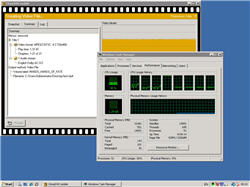Ripping vs. Transcoding

In terms of the workload on a system, what's the difference between ripping a DVD (that is, taking a DVD and copying it to the hard disk) and transcoding it (taking the DVD and changing it to a different format)? This is a question that some of you have been pondering following my post yesterday about the hammering that simultaneously transcoding six DVDs gives a dual quad-core Xeon system.
The bottom line is that ripping isn't CPU intensive, while transcoding is, and this is clearly demonstrated by the two images that follow.
Here a single instance of CloneDVD Mobile pushing one of the eight cores to 100% and the other seven to around 20%. Overall a single transcode session pushing CPU usage to around 36% - and remember that this system runs two E5472 Harpertown Xeons running at 3.00GHz each.
The next image shows the performance hit the system takes when ripping the same DVD. Here the performance hit is negligible and the system barely hits 1% CPU usage. You're going to run into hard drive bottlenecks way before the CPU starts to break a sweat when ripping. Here's the same system with the ripping paused:
CPU usage now registers 0%.
The takeaway of this is that if you want to buy/build a system for ripping DVDs then you can get away with the cheapest dual-core you can find and this will be able to handle simultaneously ripping four or even six discs at once. However, if you want to transcode these DVDs into a different format then you are going to want to get a pretty speedy quad-core processor.
For the system I'm building I've gone for the Intel Q9300 because it's a cheap quad-core, it utilizes 45nm architecture so it uses less power and runs cooler, and it supports SSE4.1 instruction set, so it's optimized for video encoding.
Thoughts?
